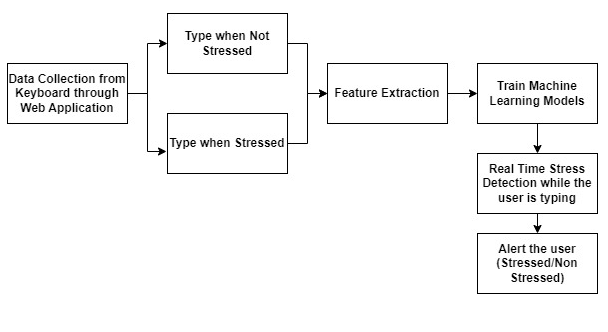Machine Learning based Stress Detection using Keyboard Typing Behavior
Main Article Content
Abstract
Emotion detection is one of those areas where technological advances have brought about significant changesin the human lifestyle. During COVID-19 pandemic, due to the work from home culture, use of computers and laptop was suddenly increased. Introduction of digital environments gave it a whole new dimension. Emotion detection is a virtual or computerized way to detect stress. People suffer from various kinds of stress in day to day activities and it is directly connected to their performance. The stress factor can be expressed through a number of ways and human behavior. The way in which humans interact with the computer can reveal the emotional state of the user, mainly the stress. Keyboard typing behavior or characteristics can be used for stress detection. This paper focuses on understanding typing behaviour of human and indicate their stress level. Relevant features are extracted from typing behavior of a user and used for training machine learning models for detection of stress. K-Nearest Neighbor algorithm gave highest accuracy of 84.21% with dimensionality reduction approach.
Article Details
References
Zimmermann, Philippe, et al. “Affective computing—a rationale for measuring mood with mouse and keyboard.” International journal of occupational safety and ergonomics 9.4 (2003): 539-551.
Hernandez, Javier, et al. “Under pressure: sensing stress of computer users.” Proceedings of the SIGCHI conference on Human factors in computing systems. ACM, 2014.
Vizer, L. M., Zhou, L., & Sears, A. (2009). Automated stress detection using keystroke and linguistic features: An exploratory study. International Journal of Human-Computer Studies, 67(10), 870-886.
Kumar, N. V. M. ., Raju, D. N. ., PV, G. ., & Subhashini, P. (2023). Real-Time User-Service Centric Historical Trust Model Based Access Restriction in Collaborative Systems with Blockchain Public Auditing in Cloud. International Journal of Intelligent Systems and Applications in Engineering, 11(2s), 69–75. Retrieved from https://ijisae.org/index.php/IJISAE/article/view/2509
B. Kabi, A. Samantaray, P. Patnaik and A. Routray, "Voice Cues, Keyboard Entry and Mouse Click for Detection of Affective and Cognitive States: A Case for Use in Technology-Based Pedagogy," 2013 IEEE Fifth International Conference on Technology for Education (t4e 2013), 2013, pp. 210-213, doi: 10.1109/T4E.2013.57.
S. B. Sadkhan and A. D. Radhi, "Fuzzy Logic used in Textual Emotion Detection," 2017 Second Al-Sadiq International Conference on Multidisciplinary in IT and Communication Science and Applications (AIC-MITCSA), 2017, pp. 242-245, doi: 10.1109/AIC-MITCSA.2017.8722967.
Carneiro, D., Novais, P., Augusto, J. C., & Payne, N. (2017). New methods for stress assessment and monitoring at the workplace. IEEE Transactions on Affective Computing, 10(2), 237-254.
I. Zualkernan, F. Aloul, S. Shapsough, A. Hesham, and Y. El-Khorzaty, "Emotion Recognition Using Mobile Phones", Department of Computer Science and Engineering American University of Sharjah, UAE, Computers and Electrical Engineering, vol.60, pp., 1-13-2017.
S. Ghosh, S. Goenka, N. Ganguly, B. Mitra and P. De, "Representation Learning for Emotion Recognition from Smartphone Keyboard Interactions," 2019 8th International Conference on Affective Computing and Intelligent Interaction (ACII), 2019, pp. 704-710, doi: 10.1109/ACII.2019.8925518.
L. Pepa, A. Sabatelli, L. Ciabattoni, A. Monteriù, F. Lamberti and L. Morra, "Stress Detection in Computer Users From Keyboard and Mouse Dynamics," in IEEE Transactions on Consumer Electronics, vol. 67, no. 1, pp. 12-19, Feb. 2021, doi: 10.1109/TCE.2020.3045228.

